TIG welding is a popular welding process that offers precise control and high-quality welds. However, for beginners, the equipment required for TIG welding can be overwhelming and confusing. From the power source to the filler rod, every piece of equipment plays a crucial role in the welding process.
In this article, we present a beginner’s guide to TIG welding equipment and how each component functions.
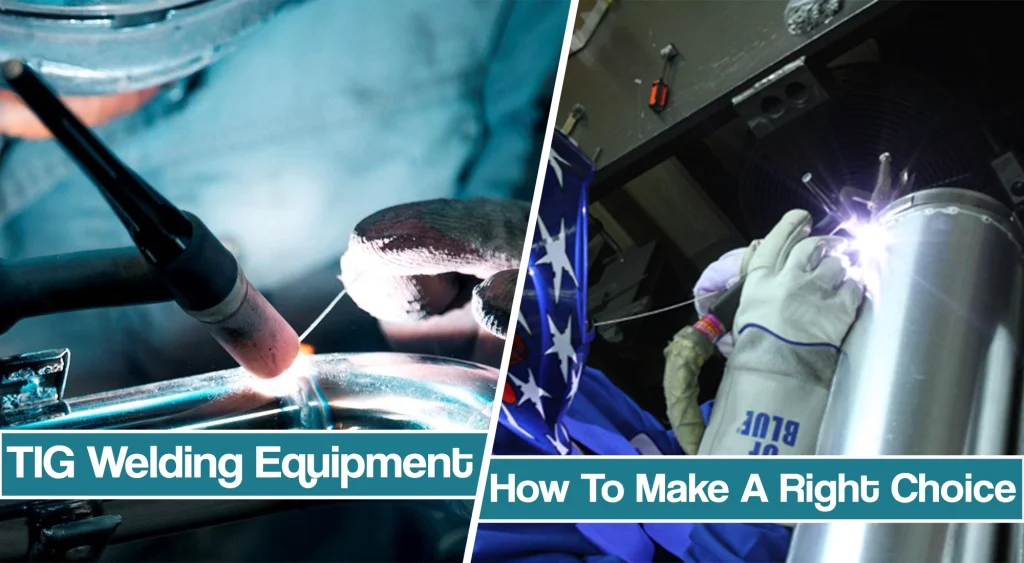
Whether you’re a hobbyist or a professional TIG welder, understanding TIG welding equipment is essential to achieve high-quality welds. So, let’s dive into the world of TIG welding equipment and discover what you need to get started!
What Is TIG Welding, And What’s The Required Equipment for it?
TIG welding or GTAW – Tungsten Inert Gas welding is a welding process that uses a non-consumable tungsten electrode to create an arc that melts the base metal and forms a weld joint.
In TIG welding, the welder manually feeds a filler rod into the weld pool to add material to the joint. The process uses an inert gas, usually argon, to shield the weld area from atmospheric contamination.
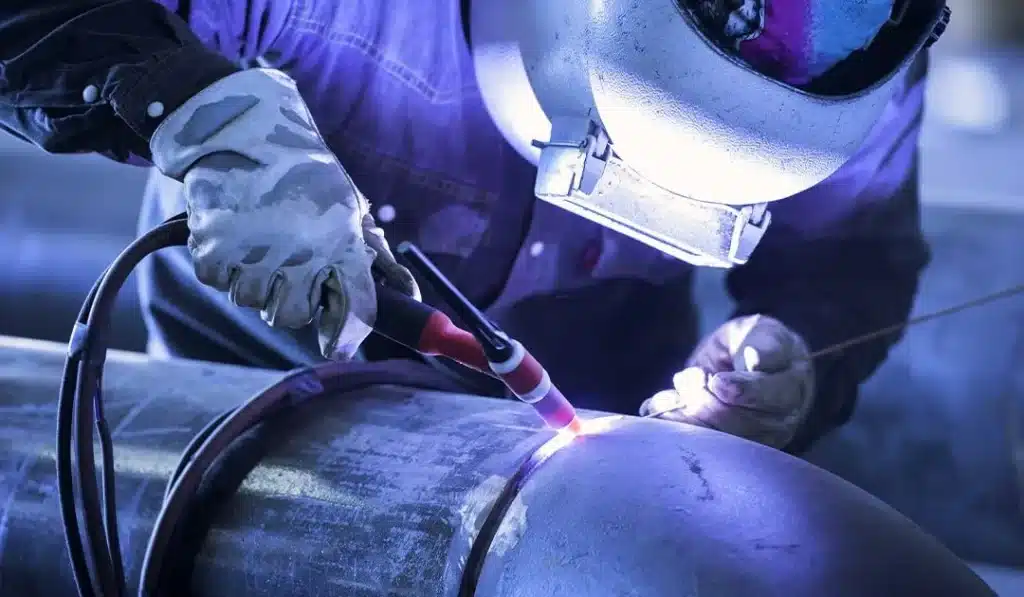
The essential equipment for TIG welding includes a power source, a TIG torch, tungsten electrodes, filler rod, a gas cylinder, and a regulator. The power source provides the electrical energy to create the welding arc, and the TIG torch holds the tungsten electrode and allows the welder to control the arc. Tungsten electrodes come in various sizes and types, and the choice of electrode depends on the material being welded. The filler rod is used to add material to the joint, and the gas cylinder provides the shielding gas to protect the weld from atmospheric contamination. The regulator controls the flow of gas from the cylinder to the TIG torch.
Power Source (TIG Welder)
The TIG process requires a specific type of welding machine known as a TIG welder or GTAW (Gas Tungsten Arc Welding) welder. TIG welders use a constant current power source and are available in both AC and DC options.
The amperage range of a TIG welder can vary depending on the model, but typically ranges from 5 to 300 amps. The amperage range required for a particular job depends on the thickness of the material being welded.
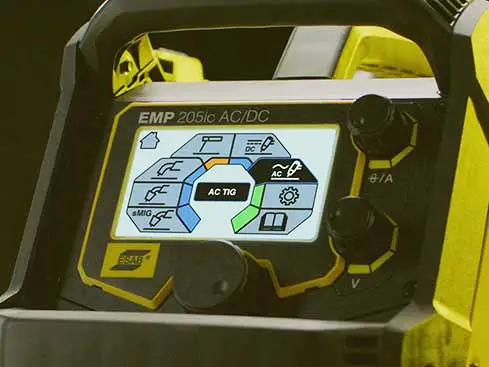
TIG welders are available in both AC and DC options. DC TIG welding is used for welding materials like stainless steel, carbon steel, and copper, while AC TIG welding is used for welding aluminum and other non-ferrous materials. The polarity of a GTAW welder can be either straight polarity (DCEN) or reverse polarity (DCEP). Straight polarity is used for welding aluminum, while reverse polarity is used for welding other metals.
A basic TIG welder comes with a power source, TIG torch, ground cable, and gas hose. It typically has a foot pedal control for amperage adjustment and gas flow control. TIG welders come with various controls that allow the welder to adjust the welding parameters. Basic controls include amperage adjustment, foot pedal control, and gas flow adjustment. Advanced controls include pulse welding, AC balance control, and waveform adjustment.
Advanced TIG welders come with additional features such as pulse welding, which allows the welder to alternate between high and low amperage to achieve better control of the heat input. AC balance control allows the welder to adjust the balance between the cleaning and penetration effects of the AC welding arc. Waveform adjustment allows the welder to adjust the shape of the welding arc for better control and improved weld quality. Some TIG welders also come with advanced features like remote control capabilities, programmable settings, and memory functions.
TIG Welding Torch
TIG welding torches are a crucial component of the TIG welding process, as they hold the tungsten electrode and allow the welder to control the welding arc. TIG torches come in various sizes and configurations, and choosing the right torch for the job is essential to achieve high-quality welds.
The main components of a TIG welding torch are as follows: Handle, Head, Collet, Gas lens, Cup and Cable. The handle is the part of the torch that the welder holds while welding. It is usually made of heat-resistant material, such as rubber or silicone.
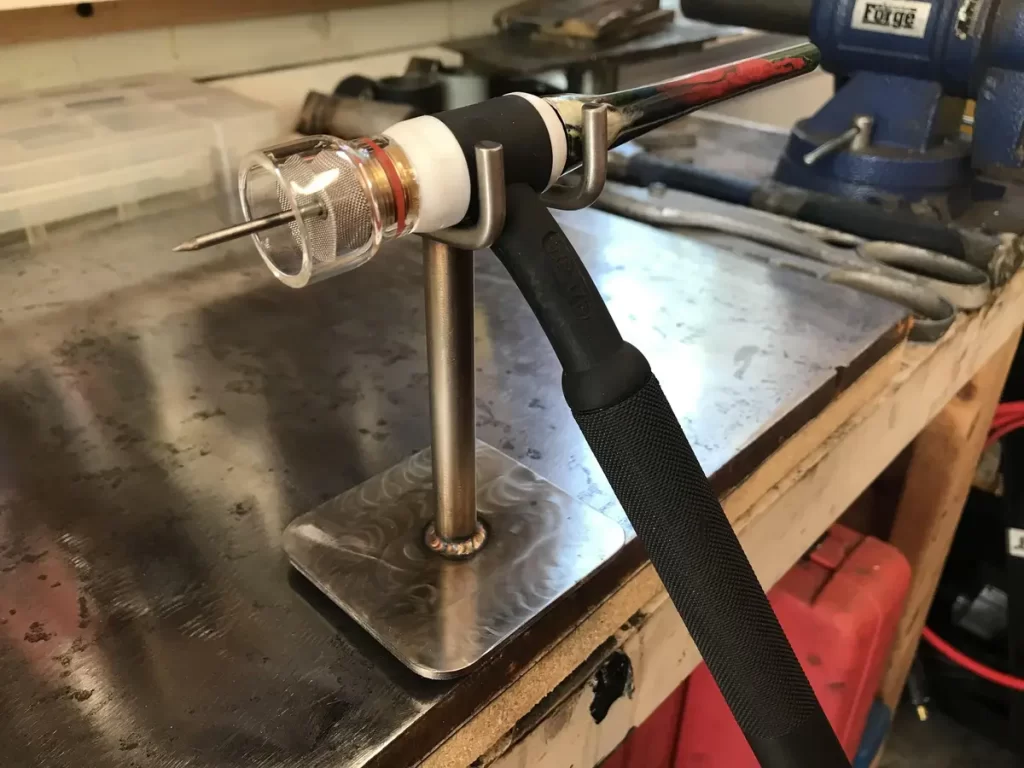
The head of the torch holds the tungsten electrode and controls the flow of shielding gas. It is usually made of copper or brass. The collet holds the tungsten electrode in place and is tightened by the collet body. The size of the collet and collet body depends on the diameter of the tungsten electrode being used. The gas lens is a replaceable component that helps to distribute the shielding gas evenly around the welding area, reducing turbulence and improving weld quality.
The cup, also known as the nozzle or gas diffuser, controls the flow of shielding gas around the welding area. It is usually made of ceramic or glass and comes in various sizes and shapes. The cable connects the TIG torch to the power source and provides the electrical current needed to create the welding arc.
- Sizes: TIG torches are available in different sizes, ranging from small, lightweight torches for hobbyists and DIYers to larger torches for industrial welding applications. The most common sizes for TIG torches are 9, 17, 18, 20, and 26.
- Cooling: TIG torches can be air-cooled or water-cooled. Air-cooled torches are generally smaller and less expensive but have a lower duty cycle and are not suitable for high-amperage welding. Water-cooled torches are more expensive but have a higher duty cycle and are suitable for high-amperage welding.
Tungsten Electrodes
Tungsten electrodes are a critical component of the TIG welding process, as they form the welding arc that melts the base metal and forms the weld joint. Tungsten electrodes are non-consumable, which means that they do not melt during the welding process. The choice of tungsten electrode depends on the material being welded and the welding parameters.
Common sizes: Tungsten electrodes come in various sizes, ranging from 0.5mm to 10mm in diameter. The most common sizes for TIG welding are 1.6mm (1/16″), 2.4mm (3/32″), and 3.2mm (1/8″).
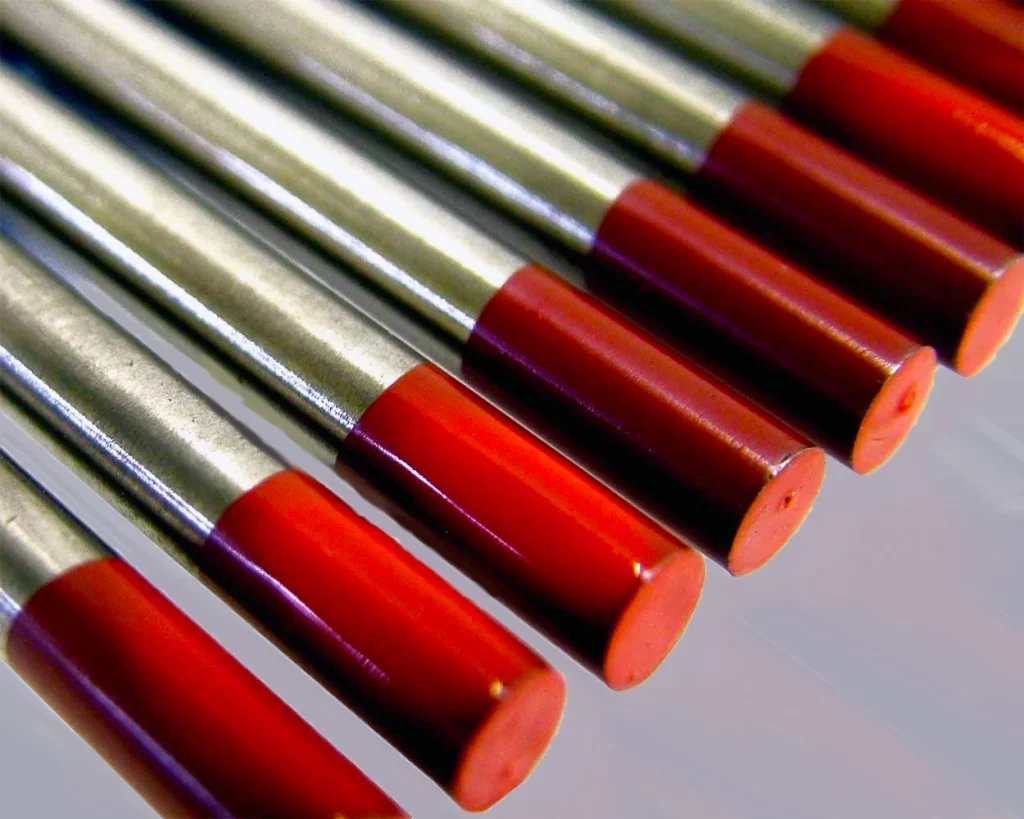
Tungsten Types
There are several types of tungsten electrodes used in TIG welding, including pure tungsten, thoriated tungsten, ceriated tungsten, lanthanated tungsten, and zirconiated tungsten.
- Pure tungsten: Pure tungsten electrodes are made of 99.5% tungsten and have a green tip. They are not recommended for DC welding, as they have poor arc starting properties and can contaminate the weld with tungsten inclusions. They are primarily used for AC welding of aluminum and other non-ferrous metals.
- Thoriated tungsten: Thoriated tungsten electrodes are made of tungsten and thorium oxide and have a red tip. They have excellent arc-starting properties and can be used for both AC and DC welding. However, welders are mainly using them for DC welding of carbon and stainless steel, as one of the most widely used types in TIG welding.
- Ceriated tungsten: Ceriated tungsten electrodes are made of tungsten and cerium oxide and have a gray tip. They have good arc-starting properties and can be used for both AC and DC welding. They are mainly used for DC welding of carbon and stainless steel.
- Lanthanated tungsten: Lanthanated tungsten electrodes are made of tungsten and lanthanum oxide and have a gold tip. This is an all-purpose electrode, with excellent arc starting characteristics and the ability to transmit high current without spitting. It provides a stable arc at both high and low current and works very well on all metals..
- Zirconiated tungsten: Zirconiated tungsten electrodes are made of tungsten and zirconium oxide and have a brown tip. They are a more durable alternative to pure tungsten, which is good for welding aluminum, magnesium and nickel alloys. It has a high current-carrying capacity, and it provides better arc starts and stability than pure tungsten.
- Rare earth tungsten: Rare earth electrodes are made of tungsten, and the addition of any element must be specified by the manufacturer. These additions improve arc characteristics, and these electrodes are usually used in specific applications. Rare earth tungsten must carry a color different from other classified tungsten electrodes.
TIG Filler Rods
Filler rods are a critical component of the TIG welding process, as they provide the additional metal needed to create the weld joint. Filler rods are usually made of the same material as the base metal being welded or a compatible alloy. The choice of filler rod depends on the material being welded, the welding parameters, and the desired weld characteristics.
Filler rods come in various sizes, ranging from 0.8mm to 6.4mm in diameter. The most common sizes for TIG welding are 1.6mm (1/16″), 2.4mm (3/32″), and 3.2mm (1/8″). Filler rods are usually made of a combination of metals and alloys that provide the desired properties for the weld joint.
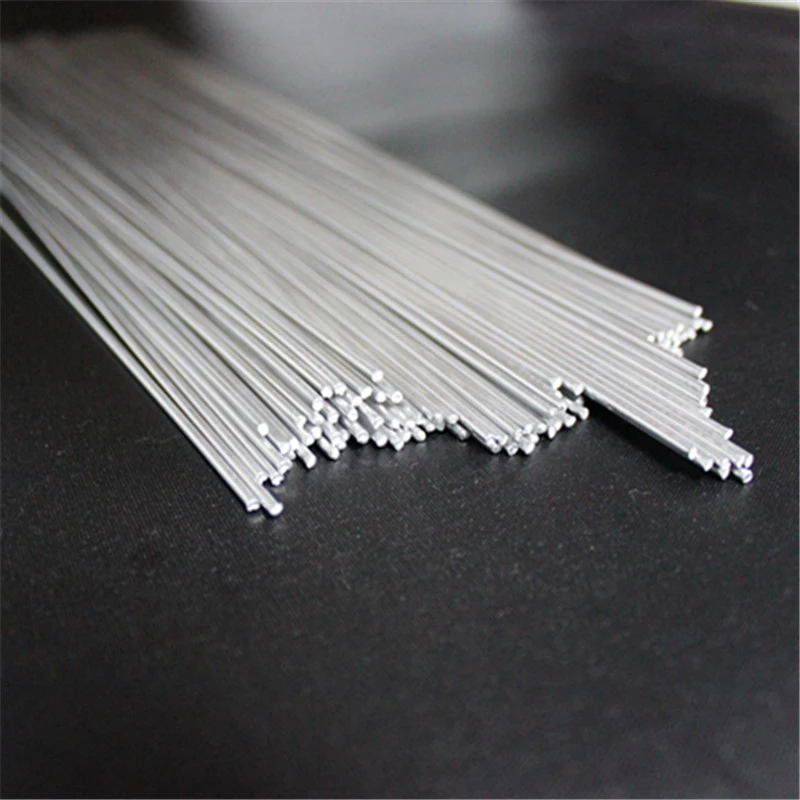
Filler rods are fed into the weld puddle by the welder and melted to create the weld joint. The welder must select the right filler rod for the job to achieve high-quality welds. It’s essential to match the filler rod to the base metal and select the right diameter to ensure proper weld penetration.
There are various types of filler rods used in TIG welding, including:
- ·ER70S-6: This is a general-purpose filler material used for welding mild steel. It provides good penetration and can be used for both thin and thick sections.
- ER308L: This is a filler rod used for welding stainless steel. It has a low carbon content and provides good corrosion resistance.
- ER4043: This is a welding rod used for welding aluminum. It has a low melting point and provides good corrosion resistance.
- ER5356: This is a filler rod used for welding aluminum and magnesium alloys. It has a higher strength and better corrosion resistance than ER4043.
Shielding Gases And Shielding Gas Supply
Shielding gases are a critical component of TIG welding, as they protect the TIG weld pool from atmospheric contamination, which can lead to defects in the weld joint. The choice of shielding gas depends on the material being welded and the desired weld characteristics.
Common shielding gases used in TIG welding:
- Argon: Argon is the most commonly used shielding gas for TIG welding. It’s an inert gas that provides excellent coverage of the weld pool and helps prevent oxidation of the weld metal. Argon is suitable for welding all materials, including TIG welding aluminum, stainless steel, and carbon steel.
- Helium: Helium is an active gas that provides a hotter and more penetrating arc than argon. Therefore, it’s suitable when welding thicker pieces, but it is expensive and it can cause burn through on sheet metal.
- Argon/Helium mixtures: Mixtures of argon and helium are sometimes used for TIG welding. These mixtures provide a hotter and more penetrating arc than pure argon and are suitable for welding thicker sections of aluminum and other non-ferrous metals.
- Argon/Hydrogen mixtures: Mixtures of argon and hydrogen can be used for TIG welding but only in specific applications and with care. Hydrogen is a reactive gas that provides a hotter arc than argon and can improve weld penetration. However, the use of hydrogen can also increase the risk of porosity in the weld, so it is used when welding specific stainless steel grades.
The shielding gas is supplied to the weld from the gas cylinder with the regulator, gas hose, and to gas lens. Shielding gases are stored in high-pressure cylinders and are typically rented from welding supply companies. The gas cylinder should be equipped with a regulator to control the flow of gas to the welding torch. The gas hose connects the gas cylinder to the regulator and the welding torch.
The flow meter is used to measure the flow rate of the shielding gas and ensure that the correct amount of gas is delivered to the weld. The gas lens is a diffuser that helps distribute the shielding gas evenly around the weld pool and improve the coverage of the weld.
Gas Flow Regulator
Gas flow regulators are an essential component of TIG welding, as they control the flow of shielding gas to the welding torch. The regulator is connected to the gas cylinder and ensures that a constant flow of gas is delivered to the torch.
A single-stage regulator is the most basic type of regulator used in TIG welding. It reduces the high pressure in the gas cylinder to a lower pressure suitable for welding. The output pressure is not as consistent as a two-stage regulator, but it is suitable for most TIG welding applications.
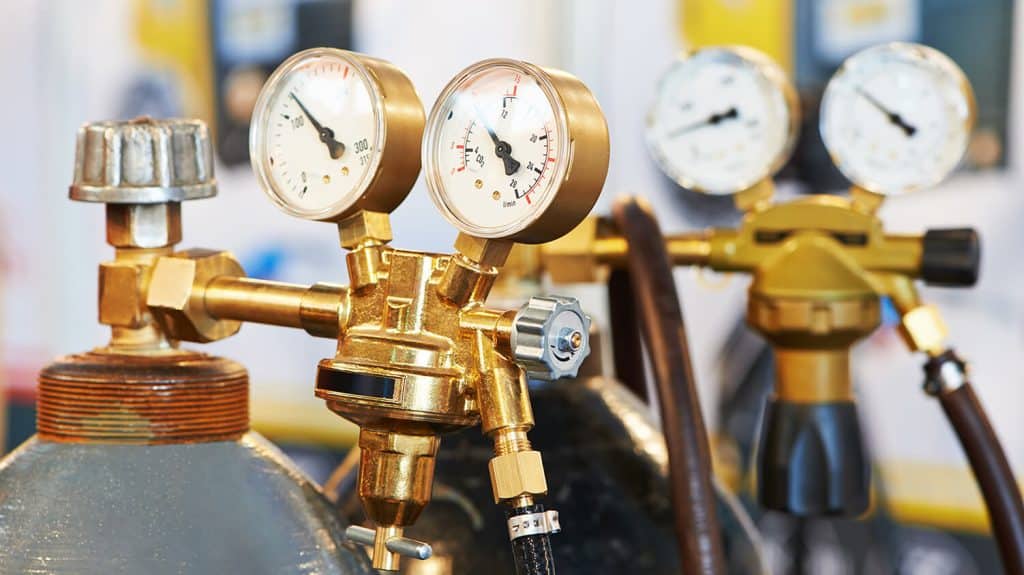
A two-stage regulator is more precise than a single-stage regulator. It has two separate chambers that reduce the high pressure in the gas cylinder to a lower pressure suitable for welding. The first stage reduces the pressure to an intermediate level, and the second stage further reduces it to the desired level. Two-stage regulators are more expensive than single-stage regulators but provide a more consistent flow of gas.
A piston-type regulator is a high-precision regulator that uses a piston to control the flow of gas. It provides a consistent flow of gas, even when the cylinder pressure drops. Piston-type regulators are more expensive than other types of regulators but are ideal for high-precision TIG welding applications.
TIG Welding Protective Equipment
Compared to other welding processes, TIG welding generally requires lighter protective equipment because the arc is less bright and produces fewer sparks. However, the protective equipment requirements depend on the welding current, the material being welded, and other factors specific to the welding application.
- Welding helmet: A welding helmet is required to protect the welder’s face and eyes from the intense light and heat produced during TIG welding. The helmet should have a shade number appropriate for the welding current and arc intensity. TIG welding requires a lighter shade than other welding processes because the arc is less bright, and the auto-darkening filter should support a low amp start.
- Protective clothing: Welders must wear protective clothing to prevent skin exposure to harmful radiation, sparks, and heat. Clothing should be made of flame-resistant materials, such as leather, and cover as much skin as possible. TIG welding does not produce as many sparks as other welding processes, so lighter clothing can be worn, and you want to focus more on dexterity.
- Welding gloves: Welding gloves are required to protect the welder’s hands from the heat and sparks produced during TIG welding. Gloves should be made of heat-resistant materials, such as leather. However, due to lower heat input, TIG welding gloves are usually made of thinner goatskin leather that allows better torch manipulation.
- Respirator: A respirator may be necessary if the welding process produces fumes or gases that can be harmful to the welder’s health. The type of respirator required depends on the materials being welded and the level of ventilation in the welding area, especially when TIG welding magnesium or zinc, whose fumes can be highly toxic.
Conclusion
TIG welding is a popular welding process that offers many advantages over other welding processes, such as MIG welding or Stick welding, including precise control, clean welds, and excellent weld quality. TIG welding requires specialized equipment, including a TIG welding machine, a TIG torch, tungsten electrodes, filler metal, and shielding gas.
With the right equipment, knowledge, and skills, TIG welding can be an excellent choice for many welding applications, from automotive and aerospace to art and jewelry making. If you need more tig welding tips or are willing to learn TIG welding, be sure to check our other articles.
Resources
- https://www.twi-global.com/technical-knowledge/job-knowledge/equipment-for-tungsten-inert-gas-tig-gta-welding-017
- https://www.millerwelds.com/resources/article-library/tig-it-how-a-tig-welder-works-and-when-to-tig-weld
- https://fractory.com/tig-welding-explained/
- https://www.twi-global.com/technical-knowledge/job-knowledge/tungsten-inert-gas-tig-or-gta-welding-006
- https://www.keyence.com/ss/products/measure/welding/arc/tig.jsp





